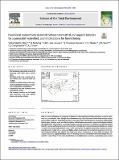Por favor, use este identificador para citar o enlazar a este item:
http://hdl.handle.net/10261/220794COMPARTIR / EXPORTAR:
 SHARE SHARE
 CORE
BASE CORE
BASE
|
|
| Visualizar otros formatos: MARC | Dublin Core | RDF | ORE | MODS | METS | DIDL | DATACITE | |

| Título: | Functional connectivity network between terrestrial and aquatic habitats by a generalist waterbird, and implications for biovectoring |
Autor: | Martín-Vélez, Víctor CSIC ORCID; Mohring, B.; Leeuwen, Casper H.A. van; Shamoun-Baranes, Judy; Thaxter, Chris B.; Baert, J.M.; Camphuysen, Cornelis Jan; Green, Andy J. CSIC ORCID | Palabras clave: | GPS tracking Larus fuscus Landfills Movement ecology Network analysis Wetlands |
Fecha de publicación: | 2020 | Editor: | Elsevier | Citación: | Science of the Total Environment, 705 (2020) | Resumen: | Birds are vectors of dispersal of propagules of plants and other organisms including pathogens, as well as nutrients and contaminants. Thus, through their movements they create functional connectivity between habitat patches. Most studies on connectivity provided by animals to date have focused on movements within similar habitat types. However, some waterbirds regularly switch between terrestrial, coastal and freshwater habitats throughout their daily routines. Lesser black-backed gulls that overwinter in Andalusia use different habitat types for roosting and foraging. In order to reveal their potential role in biovectoring among habitats, we created an inter-habitat connectivity network based on GPS tracking data. We applied connectivity measures by considering frequently visited sites as nodes, and flights as links, to determine the strength of connections in the network between habitats, and identify functional units where connections are more likely to happen. We acquired data for 42 tagged individuals (from five breeding colonies), and identified 5676 direct flights that connected 37 nodes. These 37 sites were classified into seven habitat types: reservoirs, natural lakes, ports, coastal marshes, fish ponds, rubbish dumps and ricefields. The Doñana ricefields acted as the central node in the network based on centrality measures. Furthermore, during the first half of winter when rice was harvested, ricefields were the most important habitat type in terms of total time spent. Overall, 90% of all direct flights between nodes were between rubbish dumps (for foraging) and roosts in other habitats, thereby connecting terrestrial and various wetland habitats. The strength of connections decreased between nodes as the distance between them increased, and was concentrated within ten independent spatial and functional units, especially between December and February. The pivotal role for ricefields and rubbish dumps in the network, and their high connectivity with aquatic habitats in general, have important implications for biovectoring into their surroundings. | Versión del editor: | https://doi.org/10.1016/j.scitotenv.2019.135886 | URI: | http://hdl.handle.net/10261/220794 | DOI: | 10.1016/j.scitotenv.2019.135886 |
| Aparece en las colecciones: | (EBD) Artículos |
Ficheros en este ítem:
| Fichero | Descripción | Tamaño | Formato | |
|---|---|---|---|---|
| Andy.pdf | 1,25 MB | Adobe PDF |  Visualizar/Abrir |
CORE Recommender
SCOPUSTM
Citations
29
checked on 07-may-2024
WEB OF SCIENCETM
Citations
24
checked on 27-feb-2024
Page view(s)
121
checked on 18-may-2024
Download(s)
184
checked on 18-may-2024
Google ScholarTM
Check
Altmetric
Altmetric
Este item está licenciado bajo una Licencia Creative Commons

